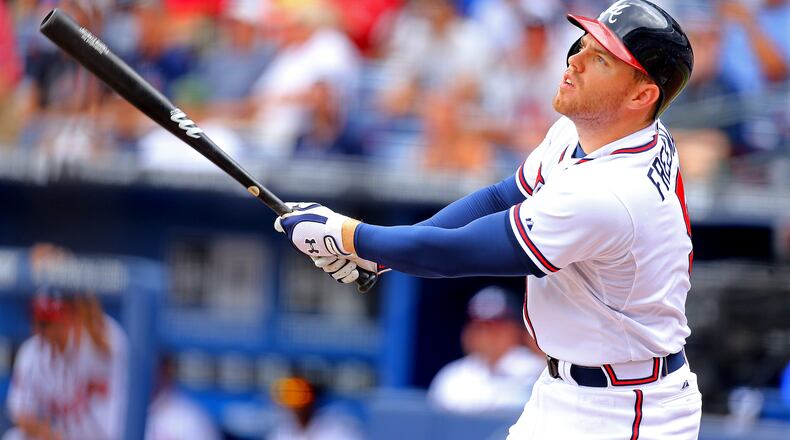Braves first baseman Freddie Freeman is a not an engineer. But he is a power hitter who sends many of his homers to left-center field. So he’s taken a particular interest in the dimensions at SunTrust Park for practical rather than aesthetic considerations.
Already, Freeman has suggested an additional feature to general manager John Coppolella for the ballpark that will become the Braves’ new home next spring.
“I’m already on Coppy to see if we can get a party deck put in left-center and bring the fences back in,” Freeman said, laughing.
After 20 years at Turner Field, a relatively generic park with a rounded outfield wall, the Braves wanted SunTrust Park to have a distinctive look and feel. To that end, they created a stadium with asymmetrical dimensions that create unique outfield angles with walls that vary greatly in height from one foul pole to the other.
The more important consideration for Braves players is how the new ballpark will play. Data showed that Turner Field proved to be more favorable to pitchers in most seasons. The answer in 2017: No one knows for sure.
But the team’s best guess, after conducting wind tests and factoring in its dimensions, is that SunTrust will be a relatively neutral stadium for pitchers and hitters.
“We think it’s going to be similar to what we have here,” Braves general manager John Coppolella said the day after the Braves played their final game at Turner Field. “Maybe slightly more hitter-friendly, but overall (still) more pitcher-friendly than hitter-friendly.”
Until the Braves play some games at the new place, all that’s known for sure is that some of its dimensions are vastly different than at Turner Field.
Freeman’s concern is that the left-field power alley will measure 385 feet at the new park, compared to 380 at Turner Field. The wall will also be two inches higher at 8 feet, 8 inches. Freeman said he’s putting his faith in those wind studies that, Braves officials told him, predicted the wind will be blowing out to left-center on most days.
Straightaway center field at SunTrust will be 400 feet, same as Turner Field. But it will measure 402 feet just to the left and right of dead center.
SunTrust Park will measure 335 feet to the left-field foul pole, also the same as Turner Field. But the new park will feature a 6-foot fence in the left-field corner as compared to the uniform 8-6 height for the entire outfield wall at Turner Field.
The visitors’ bullpen at SunTrust will be located beyond the wall in the left-field corner. A diagram provided by the team indicates the left-field wall will measure 8-8 from the side of the bullpen closest to center field all the way around to the Braves’ bullpen in right-center.
The biggest difference in dimensions will be from center to right. The right-center power alley at SunTrust will measure 375 feet, 15 feet closer than at Turner Field. But the wall will measure nearly twice as high at 16 feet.
Freeman, who bats left, doesn’t hit many homers to that part of the park but theoretically could pull more balls for hits in the new stadium.
“I’ve probably had 20 to 25 balls caught at that warning track, so maybe those will turn into hits again,” Freeman said. “(Turner Field) is a big park. Hopefully SunTrust Park plays a lot more fair.”
Of course, “fair” is a subjective term. For power hitters like Freeman, fair can mean a stadium in which most hard-hit balls either leave the park or drop in near the wall for extra-bases.
That doesn’t describe Turner Field. A FanGraphs study determined the Ted tied with Arizona’s Chase Field for the fourth-largest outfield area among the 32 ballparks, behind Kansas City, Colorado and Detroit.
At Turner Field, Freeman hit 64 career home runs on 1,176 balls put in play (one per every 18.4), compared to 74 homers on 1,308 balls put in play (one per 17.7) in other parks.
“I get excited when I go on the road,” Freeman said. “Turner Field is a very tough place to hit. That’s where balls go to die. You can hit home runs to the first row that are 30 rows deep in a lot of other places. So when you get on the road, you know you can take advantage of those parks, so you get a little bit more excited.”
For Braves center fielder Ender Inciarte, a “fair” park means yet something else.
Inciarte doesn’t hit many home runs so a closer fence isn’t really a big concern. In fact, as a defensive-minded center fielder with speed, a larger outfield means more room for Inciarte to chase down long fly balls.
“As a center fielder I really like those gaps where I can run and track long fly balls if I have to,” Inciarte said. “So Turner Field has been really good for me and I’ve heard the new ballpark is going to be very similar, except that the right-center gap is going to be shorter and the left-center gap is going to be almost the same. It’s perfect.”
In spite of an organizational philosophy centered on strong pitching, the Braves anticipate their new ballpark won’t be a pitcher’s haven like those in Seattle, San Diego and Los Angeles.
“Until it plays, we won’t know,” Coppolella said.




